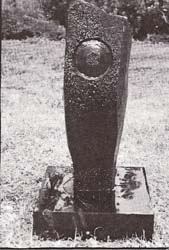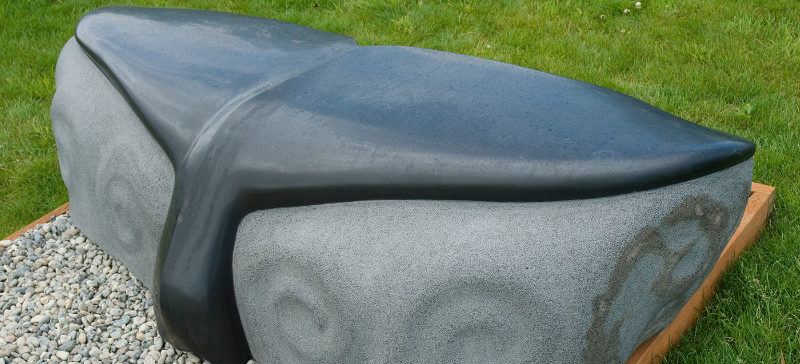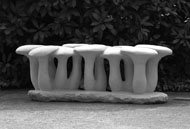
This is an interview with Tamara Buchanan which took place on May 12, 1996 at her studio/home in Kirkland, Washington.
She has been a NWSSA board member since 1994. Over a period of twenty years, she developed the Sweetbriar Wholesale Nursery in Kirkland, which she owns and operates with her husband Doug Benoliel. She recently spent a month carving marble in Carrara, Italy.
We started with a tour of her studio, which consists of an indoor workshop filled with a variety of stones, tools, and her new heavy duty compressor. Tamara was excited about the compressor and all that it could do! In fact, it was important enough to deserve .3 name–she called it Curtis. We hugged it in appreciation! Then we moved on to her carving area outside where we began our conversation with a question about a sculpture in progress.

Steve Sandry: Tell me about your process with this piece.
Tamara Buchanan: I had an idea for a very large sculpture. I was in love with a concept, and I was trying to bring that idea to the stone. But the stone didn’t want to be that. I occasionally look at it, touch it, feel it and ask what it wants to be. So far it’s being very stubborn, and that’s ok.
SS: Has that happened before?
TB: The most magical time was one of my first pieces, a piece of translucent Greek Alabaster. I was going to make a bird with outstretched wings, so I could shine light through it–I would have this airy ethereal bird. I was carving away, but the next day, it was screaming at me that it wanted to be something rounded. I went with it. It became the Nautilus piece “Solitude”, which really pleases me. I’m allowing myself the time and the grace to listen. Doesn’t happen frequently, but those times are magic!
SS: Do you ever use a more rational planning and executing process?
TB: With the large limestone figure it was close to that process. I started whacking away and realized I should decide what I wanted to do here. So, .I went back, got photos to work from and did a couple of models Although, I’m not a truly planning type person, the inspiration came from a lovely art photograph.
SS: How did you feel about that process?
TB: I feel ok with it. I do find I lose some spontaneity working with a model. It’s fun when the flow is happening. That’s great!
My first experience with carving was at the first symposium in 1987. George Pratt was there and got me started on a piece of limestone. And Lee Gass gave me a piece of Mexican onyx which was my first hard stone. He started me on his diamond tools. So, I skipped the business of soapstone. I like something I can hit and it won’t shatter. Granite and marble are marvelous stones for me. get joy from both of them.
SS: What is it about the resistance the harder stones give you that is appealing?
TB: The Italians call marble “bones of the earth”. It feels grounded, solid, earthy. They are not so brittle or tender that they would shatter if hit the wrong way. It disturbs me to be working with alabaster and be so concerned with bruising it.
I find I’m carving faster. I started pushing in that direction last summer–not worrying or stewing so much, but letting energies come through. I used that approach in Italy. I had just a month to work there and wanted to get as much started as I could. I was roughing out about a piece and a half per week. That felt really good–to think and work, but also to not think and work. To let the stone, tools and my hands have communication– that’s where I think I’m headed. I worked daily 8:00 to 5:00, and found I could physically do it. I learned a lot about myself: what I can handle, what I can do. I learned patience and trust.

SS: What was the studio like in Italy?
TB: It was a pop and son type operation– mostly custom work or reproductions of their own models. It was small, intimate. It’s mostly a teaching studio now. They move stone with pry bar and roller. Most of the carving is done with air tools.
SS: How did the student-teacher relationship work?
TB: It was Silvereo’s studio. He was there to give whatever instruction I wanted. Most of the time he would ask if I needed help. A few times he insisted I learn to sharpen tools.
SS: Why did you go sculpt in Italy?
TB: I knew that I had to go. I wasn’t sure why. In retrospect it was to learn patience and to learn to trust in my work with stone and also in general in my life. Perhaps I may have found my next mentor: an elderly sculptor, Enzo Pasquinni. I felt he wanted to share his knowledge and expertise. I’d like to go back in 1997 to work in his studio. I think there are some things he can teach me about art, stone, and maybe about life.
I think mentors are very important. That’s another good thing about the Association. It can provide access to mentors that you can’t find in the studio by yourself. George Pratt has always been my mentor along the way. I missed him at the last symposium, for my yearly “how am I doing, George?”
I discovered while working in Italy that many of the artists, famous Of unknown, come there for some of the same reasons we go to the Symposium. Italy was the only place they could go to find the comradery and support, both technical and emotional. There was a man from Vancouver Island, B.C. who didn’t know there was a support system available to him locally. Sometimes we don’t realize we have something so special.
SS: How did you know to enter a mentoring process?
TB: Because it was available. And I so badly wanted to sculpt. I knew that this is what I should be doing. I came into it at a time when I was facing my own mortality from a cancer scare. I’d also had some losses of significant people in my life and my dog of nineteen years who was like my son. Many things, all at once, came crashing down. What I turned to was the stone. It is very grounding. I love being dusty; I love to touch the stone-smooth, rough, chisel marks, all of it.
I have a very stable life now. I have someone in Doug who believes in me and accepts me for the prickly person I can be sometimes. He’s been incredibly supportive. It’s taken major setbacks in my physical and emotional health for me to realize “I can try this”. And then I stumbled into The Artist’s Way by Julia Cammeron. Very synchronous. I don’t think it was meant to happen sooner. Maybe I had to go through the garbage first.
SS: It sounds like things are coming together for you.
TB: I am so blessed. I have a peace now that I’ve never felt. Doug has encouraged me to take my time and not worry about selling. Enjoy doing the art; when the time, comes it will sell.
SS: As a woman, do you see your approach to art as unique?
TB: I don’t personally feel my approach to art is any different because of my sex; but it may have been seen differently because of my sex. When I started working with granite, the guys would go off to talk granite, and I would be excluded. That still happens. It’s hard to be taken seriously if you don’t create more than three or four pieces a year, but that’s not a gender thing.
SS: (We view her most recent piece “A Simple Twist” situated in an adjacent garden. It is her first completed piece from her Italian adventure.) How is this piece different for you?
TB: This piece represents a shift for me. It’s simple in content, nothing fussy about it, and it’s not representational. I enjoyed playing with it. It’s a movement of lines and contrasts. What I fmd lately is that I can’t finish anything. “A Simple Twist” was finished and then not finished. I found that during final polishing, part of me wanted to take the piece further, cut in there deeper, etc. So, it never ends. The limestone piece “Emerging” is a large bud shape with two petals in a semi-open position around the bud. I really want to change that piece. It’s technically finished, but I had a vision that the cone is supposed to be a face, pointing upward. I can’t wait to recarve it.

SS: So, you have a way of staying in process with your pieces?
TB: This is new for me. I am trusting that it can be finished or not finished and be ok. The process can continue. Not rushing, having patience. Before I had an orientation of having to finish and getting it sold, which was self-imposed. That’s changed.
SS: What was your early experience with art?
TB: Here’s a drawing story: I was asked to leave the department at WWSU because I didn’t have any talent: so much for being an art major. The Artist’s Way helped me out of that horror story.
I did have a wonderful high school sculpture instructor, John Pilikowsky. I got a lot of encouragement and felt some success in his class. He handed me a rock at the end of school and said “I think you can do something with this. “. I took it home and thought about that rock for the next twenty years. At that point I found out about the 1987 Symposium, which was the first one. I’ve been to all the Symposia since, and still playing with rocks.
SS: When did you become a board member? And how has that been for you?
TB: The first time was 1994. I felt I had skills that could be used by the Association. It’s a lot of work, time and emotional commitment. I also appreciate getting to know the Board members.
It’s fun to watch the Association grow and change. Having been on other major boards of directors, I have strong feelings about what the Board is supposed to be doing. Our job is to manage the business of the Association. We now use a budget, we have an accountant, we have a way of managing the records, and we’ve obtained non-profit status. Now we can proceed with a project–like creating a sculpture center. We’re getting art more and more sophisticated.
NWSSA is really driven by its members. It’s important for the membership to understand and remember that. Membership comments and input is what moves the Board in a direction. We welcome hearing about the concerns of the membership.
One new project I’m interested in is the possible development of a sculpture center at the former Sandpoint Naval Airstation. It will need energy and talent to develop, and we’ve got it. For instance, we’ll need help grant writing and fund raising.
SS: What do you mean by “pushing the stone”?
TB: It goes back to “when are you finished?” …. wanting to express more feeling and depth.
For instance, you guide and move the light to convey emotion. I have always worked with lights, darks and shadows. Now I want to work with lights and lights! Allowing light to come through a piece, not just through the stone itself, but through some piercings in the stone. Also, you polish different parts to different levels. The light hits the various areas in different ways and you’re able to control how the eye moves over the piece. The light and the stone together are the sculpture.

SS: Are you selling pieces?
TB: I sell at our nursery to landscape architects and contractors. I sold eight or nine small works at the open house show. I believe in George Pratt’s approach. You start people out as collectors by selling small “coffee table pieces”. Then they’re your collector. They’re more confident, and they start buying more important works. That’s happening for me.
SS: What is your advice for other artists?
TB: Read The Artist’s Way. Surround yourself with people as supportive as my husband. Keep a sense of humor. Have fun!










We need some kind of descriptive text here.